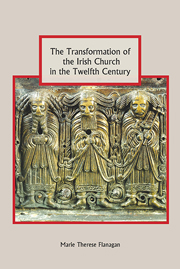Book contents
1 - Charting change in the twelfth-century Irish church: the problem of sources
Published online by Cambridge University Press: 05 October 2013
Summary
The Irish church underwent a radical transformation during a ‘long twelfth century’, but the sources of inspiration, as well as the modes of implementation of change, remain frustratingly obscure. There is no substantial or coherent body of material bearing on the movement for renewal, and, consequently, evidence has to be pieced together from a wide variety of disparate and often fragmentary sources. The annals, originating within monastic institutions, constitute an important source, although their value for the twelfth century is greatly reduced by gaps in the principal collections. There are lacunae in the Annals of Ulster between 1131 and 1155, the Annals of Inisfallen between 1131 and 1158 and the Annals of Loch Cé between 1139 and 1169, while Chronicum Scotorum terminates in 1150 (the entries between 1136 and 1140 are also missing), and coverage in the Annals of Tigernach ends in 1176.2 In any case, annals generally provide only unconnected notices, such as the deaths of important ecclesiastics and kings, attacks on churches and monasteries, and reports of royal assemblies, councils and synods, but little elaborated information. They are usually devoid of elements such as causation, motivation, and character development, the kind of narrative evidence upon which historians typically depend. All manner of events from weather conditions to death-notices, military engagements and the burning of churches – often recorded without any indication of whether a fire was accidental or deliberate – are juxtaposed as if equal in importance and without causal connections or the subordination of one element to another.
- Type
- Chapter
- Information
- Publisher: Boydell & BrewerPrint publication year: 2010



